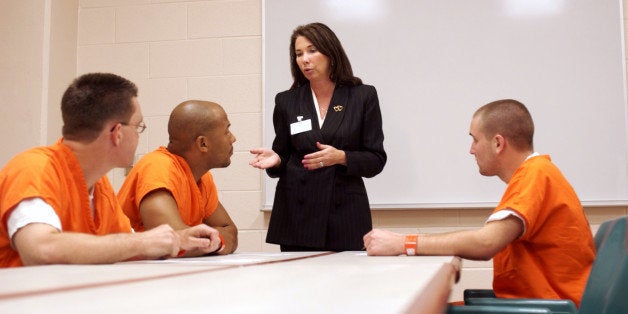
The federal government is putting prisons on notice, reminding them that incarcerated students with disabilities are legally entitled to the same rights and protections granted to students with disabilities in public school settings.
In practice, this means prisons are responsible for providing things like speech therapy, hearing aids, tutoring and feeding tubes for students identified as needing them. And how prison wardens respond will have an outsize effect on the the nation's population of special-education students: One study showed that one-third of all students in U.S. jails were considered to have disabilities, while the same was true for less than one-tenth of all students nationally at the time.
"Absent a specific exception, all IDEA [Individuals With Disabilities Education Act] protections apply to students with disabilities in correctional facilities and their parents," Education Department officials Michael Yudin and Melody Musgrove wrote in a guidance letter sent this week to state and local public agencies responsible for educating incarcerated students. The letter outlines that states are also responsible for making sure that these students "are appropriately included in general State and districtwide assessments" as required under the No Child Left Behind Act.
Students identified as having a disability who are incarcerated during the academic year must be provided with the same supplementary services listed on their school-based Individualized Education Plan -- a crucial roadmap created by educators and parents to help special-education students -- or that plan must be formally re-examineed by the relevant public agency, in consultation with parents.
And beyond merely educating students with disabilities, states must evaluate and identify incarcerated students to determine whether they might be eligible for special education services. "This responsibility includes students who have never been identified as a student with a disability prior to their entry into the facility," the letter clarifies.
U.S. Attorney General Eric Holder and Secretary of Education Arne Duncan are announcing the new special-education guidance Monday morning at an event in Alexandria, Virginia. The administration is billing the effort as the next step of President Barack Obama's "My Brother's Keeper" task force, which released a report in May outlining the need to reduce "unnecessary" encounters kids have with the justice system and to improve the quality of education that occurs behind bars. Other components of Monday's announcement include a set of "guiding principles" outlining how to provide high-quality education to incarcerated youth; a letter on the civil rights of imprisoned students; a letter on Pell Grant qualifications for incarcerated youth; and a letter related to separate statutes on students with disabilities, focusing on nondiscrimination and equal access.
“Students in juvenile justice facilities need a world-class education and rigorous coursework to help them successfully transition out of facilities and back into the classroom or the workforce becoming productive members of society. Young people should not fall off track for life just because they come into contact with the justice system,” Duncan said in a statement.
The news comes amid widespread concerns that students with disabilities are suffering in jail. "Evidence suggests that proper identification of students with disabilities and the quality of education services offered to students in these settings is often inadequate," Musgrove and Yudin write in their letter. Concerns include frequent mobility between prisons, overcrowding, a dearth of qualified teachers and the "inability to address gaps in students' education."
IDEA includes a provision that students with disabilities have the right to a "free appropriate public education" in the "least restrictive environment" -- in other words, they must be given accommodations for their disability while being included with their typically able peers to the greatest extent possible. Monday's guidance reiterates that incarcerated students with disabilities have this right, too, and that the supplementary services they receive should help them learn the general education curriculum -- not a watered-down version. To that end, prisons "may not routinely place all students with disabilities in correctional facilities in classes that include only students with disabilities," even if it requires them to devise new setups, such as having multiple teachers in one classroom.
The guidance notes that even students with disabilities who violate discipline codes are still entitled to full services under IDEA. And removing such a student from his or her school setting for more than 10 consecutive days will touch off a bureaucratic procedure under the law.
"We hope and expect this guidance will offer a roadmap for enhancing these young people's academic and social skills, and reducing the likelihood of recidivism," Holder said in a statement.
